Need an account? Register.
 The Unofficial Demon-Spotter's Guide (Second Edition)
The Unofficial Demon-Spotter's Guide (Second Edition)
Forum Index
⇦ prev
1
next ⇨
The Unofficial Demon-Spotter's Guide (Second Edition)
Posted 09-08-2022 17:10:14
Author’s Note: This revised version has updated affiliations for the bosses, thanks to frankly incredible amount of work site user dxsire has put into making a spreadsheet of who drops what, and all individual descriptions have been updated. At over 10,000 words, this new version is over half again as long as the old version.
Editor’s Note: Please note that this is a demon-SPOTTING guide, not a demon-battling guide. Anyone looking for battle tips would be better off consulting one of the many battle guides that can be found in the castle library. This is meant to help you develop an appreciation for the many types of demon that share our world, to potentially classify new demons, and to identify what spooked your creature before it all ends in tears and an infirmary visit.
Special thanks to Ezriaphiel for risking life and limb to create visual references for all of these demons. Your sacrifices to further the cause of knowledge are greatly appreciated. Also, thank you to dxsire for your help in classifying some of the harder-to-classify demons. (Spydeer demons have a leaf affinity and not stone. Who knew?)
Additional Warning: Like all creatures, individual demons vary widely, even within a specific type. Counting on a specific demon to be slow or weak just because the last dozen of that variety were is a surefire way to wind up down a battle champion or suddenly missing appendages. The careful reader may notice discrepancies between this and the official battle guides, particularly in the abilities that various demons are said to use in battle. Remember, demons vary widely and behave differently in different situations. The same demon that forgets all of its clever elemental tricks in battle against a battle champion might have a few surprises in store in a different situation.
Historical Note: There were originally just eight demons – dark, fire, leaf, life, light, stone, water, and wind. Each of these types gradually diversified into the variety of demons we know today as the original demon battle strategy – becoming a duplicate of the opposing battle creature – became increasingly less effective. Mimicry is largely unknown today, though rumor has it that if you battle during a blizzard, you may find, for example, a ghost unglios in place of a demon.
Boss Demons: Boss demons are rare – so much so that you can take a champion from rank beginner to diamond-level contestant without even seeing one. Until very recently, there were believed to be only three types of boss demons, when it is now known that there are at least four. Despite the name, they are not appreciably stronger than the average demon – just rarer.
Affiliations: Most demons (except for some boss demons) have visual clues that allow them to be easily grouped into one of eight categories, with the recently-discovered Edgelands demons as a tentative ninth. The resemblance of the eight primary groupings to the eight clans is (with the possible exception of Dark) probably coincidental. Though demons within a category often share certain similarities, knowing a demon’s affiliation is unlikely to be of help when battling them. I cannot emphasize strongly enough that anyone trying to use this guide as an actual battle guide is likely to wind up badly injured, if not dead.
Dark: Dark-affiliated demons are black with red eyes. They tend to be smaller and weaker, but make up for in numbers what they lack in strength. Dark-affiliated demons are, with a few exceptions, among the smallest of the demons, with the buzzer demon being the size of a very large insect. They are also the most varied, with at least a dozen different types.
Fire: Fire-affiliated demons are varying shades of red. Unsurprisingly, they favor fire attacks. With the exception of the confetti demon, they are slow-moving, but many make up for this with the ability to breathe fire across alarmingly long distances.
Leaf: Leaf-affiliated demons are dark green with paler green highlights. Life-affiliated demons look similar, but have a darker base color and brighter highlights. Leaf-affiliated demons are persistent and favor thorns and poison. Luckily, the poison is slow-acting and the antidote is both stable enough to travel well and readily available at the castle. The spydeer demon is the one exception to the general color scheme. Despite looking like it should be stone-affiliated, it is in fact leaf-affiliated.
Life: Life-affiliated demons are dark green, almost black, with bright green highlights. Leaf-affiliated demons are similar, but a slightly paler green with duller highlights. It’s a subtle difference, but you can tell which one you’re facing by examining your battle champion. If it’s staggering around because of poison, you’re facing a leaf demon. If it’s staggering around out of general confusion, it’s a life demon. Life-affiliated demons disorient and confuse. Pallor fiend demons don’t fit the general color scheme, but are in fact life-affiliated.
Light: Light-affiliated demons are varying shades of yellow. They use light attacks to disorient and stun opponents. Light-affiliated demons tend to be small, often no larger than most dark-affiliated demons.
Stone: Stone-affiliated demons are various shades of brown. These tend to be very solid, resistant to damage and easily able to defend themselves. Stone-affiliated demons are among the largest demons, with crystalline and guardian demons sometimes rivaling gulper demons in size.
Water: Water-affiliated demons are dark blue with pale blue highlights. They often look like various aquatic creatures and, unsurprisingly, favor water attacks. Water-affiliated demons vary widely in size, with the auknal demon being smaller than some dark demons and the gulper demon rivaling some of the boss demons in size.
Wind: Wind-affiliated demons are a very pale blue. Some look insubstantial, but looks can be deceptive. The writhing demon doesn’t fit the overall color scheme, but is wind-affiliated.
Other Affiliations/Uncategorized:
Thirteenth Year: The Thirteenth Year demons are their own unique category. Given their ties to Thirteenth Year celebrations, they may even be some god’s idea of a holiday treat. Thirteenth Year demons are more annoying than dangerous and pose little threat to even a novice battler. Any trouble they cause is outweighed by the goodies they drop. However, it’s still not a good idea to become complacent around them. Even the most docile-seeming demon will attack if it feels threatened.
Edgelands: Edgelands demons have been corrupted enough to become their own category, no matter what their affiliation was before. Though most common beyond the Infinity Pillars, they can now be found anywhere that normal demons can live. They share a reddish-purple coloration and a tendency for wounds inflicted by teeth or claws to become corrupted in odd ways. Even a small scratch can be deadly. The good news is that other demons regard Edgelands demons with suspicion and frequently turn on them. This is probably the only reason why Edgelands demons don’t manage to take over what’s left of the world every time an Infinity Pillar opens.
You may encounter normal demons that have begun to be corrupted by the Edgelands. Treat these with particular caution. The changes are frequently subtle – sometimes nothing more than an Edgelands ticket in among the normal battle rewards.
Demons by Affiliation:
Dark: Armoury, Buzzer, Chaser, Crawler, Dark, Devourer (Boss), Feral Amorphous, Flier, Grabber, Hopper, Ooze, Seer, Slinker
Fire: Confetti, Fire, Stander, Wyrm
Leaf: Leaf, Snipper, Thorin, Spydeer (Boss), Walker
Life: Faint, Flock, Life, Pallor Fiend (Boss), Solonid
Light: Cuspid, Fish, Light, Ovid
Stone: Carrion, Crystalline, Guardian, Stone
Water: Auknal, Gulper, Threshing, Water
Wind: Flighter, Sock, Wind, Wisp, Writhing (Boss)
Edgelands: Bird, Incher, Needle, Vile
Thirteenth Year: Bat, Candee, Hat, Jester, Kitty, Pumpkin
Editor’s Note: Please note that this is a demon-SPOTTING guide, not a demon-battling guide. Anyone looking for battle tips would be better off consulting one of the many battle guides that can be found in the castle library. This is meant to help you develop an appreciation for the many types of demon that share our world, to potentially classify new demons, and to identify what spooked your creature before it all ends in tears and an infirmary visit.
Special thanks to Ezriaphiel for risking life and limb to create visual references for all of these demons. Your sacrifices to further the cause of knowledge are greatly appreciated. Also, thank you to dxsire for your help in classifying some of the harder-to-classify demons. (Spydeer demons have a leaf affinity and not stone. Who knew?)
Additional Warning: Like all creatures, individual demons vary widely, even within a specific type. Counting on a specific demon to be slow or weak just because the last dozen of that variety were is a surefire way to wind up down a battle champion or suddenly missing appendages. The careful reader may notice discrepancies between this and the official battle guides, particularly in the abilities that various demons are said to use in battle. Remember, demons vary widely and behave differently in different situations. The same demon that forgets all of its clever elemental tricks in battle against a battle champion might have a few surprises in store in a different situation.
Historical Note: There were originally just eight demons – dark, fire, leaf, life, light, stone, water, and wind. Each of these types gradually diversified into the variety of demons we know today as the original demon battle strategy – becoming a duplicate of the opposing battle creature – became increasingly less effective. Mimicry is largely unknown today, though rumor has it that if you battle during a blizzard, you may find, for example, a ghost unglios in place of a demon.
Boss Demons: Boss demons are rare – so much so that you can take a champion from rank beginner to diamond-level contestant without even seeing one. Until very recently, there were believed to be only three types of boss demons, when it is now known that there are at least four. Despite the name, they are not appreciably stronger than the average demon – just rarer.
Affiliations: Most demons (except for some boss demons) have visual clues that allow them to be easily grouped into one of eight categories, with the recently-discovered Edgelands demons as a tentative ninth. The resemblance of the eight primary groupings to the eight clans is (with the possible exception of Dark) probably coincidental. Though demons within a category often share certain similarities, knowing a demon’s affiliation is unlikely to be of help when battling them. I cannot emphasize strongly enough that anyone trying to use this guide as an actual battle guide is likely to wind up badly injured, if not dead.
Dark: Dark-affiliated demons are black with red eyes. They tend to be smaller and weaker, but make up for in numbers what they lack in strength. Dark-affiliated demons are, with a few exceptions, among the smallest of the demons, with the buzzer demon being the size of a very large insect. They are also the most varied, with at least a dozen different types.
Fire: Fire-affiliated demons are varying shades of red. Unsurprisingly, they favor fire attacks. With the exception of the confetti demon, they are slow-moving, but many make up for this with the ability to breathe fire across alarmingly long distances.
Leaf: Leaf-affiliated demons are dark green with paler green highlights. Life-affiliated demons look similar, but have a darker base color and brighter highlights. Leaf-affiliated demons are persistent and favor thorns and poison. Luckily, the poison is slow-acting and the antidote is both stable enough to travel well and readily available at the castle. The spydeer demon is the one exception to the general color scheme. Despite looking like it should be stone-affiliated, it is in fact leaf-affiliated.
Life: Life-affiliated demons are dark green, almost black, with bright green highlights. Leaf-affiliated demons are similar, but a slightly paler green with duller highlights. It’s a subtle difference, but you can tell which one you’re facing by examining your battle champion. If it’s staggering around because of poison, you’re facing a leaf demon. If it’s staggering around out of general confusion, it’s a life demon. Life-affiliated demons disorient and confuse. Pallor fiend demons don’t fit the general color scheme, but are in fact life-affiliated.
Light: Light-affiliated demons are varying shades of yellow. They use light attacks to disorient and stun opponents. Light-affiliated demons tend to be small, often no larger than most dark-affiliated demons.
Stone: Stone-affiliated demons are various shades of brown. These tend to be very solid, resistant to damage and easily able to defend themselves. Stone-affiliated demons are among the largest demons, with crystalline and guardian demons sometimes rivaling gulper demons in size.
Water: Water-affiliated demons are dark blue with pale blue highlights. They often look like various aquatic creatures and, unsurprisingly, favor water attacks. Water-affiliated demons vary widely in size, with the auknal demon being smaller than some dark demons and the gulper demon rivaling some of the boss demons in size.
Wind: Wind-affiliated demons are a very pale blue. Some look insubstantial, but looks can be deceptive. The writhing demon doesn’t fit the overall color scheme, but is wind-affiliated.
Other Affiliations/Uncategorized:
Thirteenth Year: The Thirteenth Year demons are their own unique category. Given their ties to Thirteenth Year celebrations, they may even be some god’s idea of a holiday treat. Thirteenth Year demons are more annoying than dangerous and pose little threat to even a novice battler. Any trouble they cause is outweighed by the goodies they drop. However, it’s still not a good idea to become complacent around them. Even the most docile-seeming demon will attack if it feels threatened.
Edgelands: Edgelands demons have been corrupted enough to become their own category, no matter what their affiliation was before. Though most common beyond the Infinity Pillars, they can now be found anywhere that normal demons can live. They share a reddish-purple coloration and a tendency for wounds inflicted by teeth or claws to become corrupted in odd ways. Even a small scratch can be deadly. The good news is that other demons regard Edgelands demons with suspicion and frequently turn on them. This is probably the only reason why Edgelands demons don’t manage to take over what’s left of the world every time an Infinity Pillar opens.
You may encounter normal demons that have begun to be corrupted by the Edgelands. Treat these with particular caution. The changes are frequently subtle – sometimes nothing more than an Edgelands ticket in among the normal battle rewards.
Demons by Affiliation:
Dark: Armoury, Buzzer, Chaser, Crawler, Dark, Devourer (Boss), Feral Amorphous, Flier, Grabber, Hopper, Ooze, Seer, Slinker
Fire: Confetti, Fire, Stander, Wyrm
Leaf: Leaf, Snipper, Thorin, Spydeer (Boss), Walker
Life: Faint, Flock, Life, Pallor Fiend (Boss), Solonid
Light: Cuspid, Fish, Light, Ovid
Stone: Carrion, Crystalline, Guardian, Stone
Water: Auknal, Gulper, Threshing, Water
Wind: Flighter, Sock, Wind, Wisp, Writhing (Boss)
Edgelands: Bird, Incher, Needle, Vile
Thirteenth Year: Bat, Candee, Hat, Jester, Kitty, Pumpkin
This post has been edited 1 times. Last edited on 10-31-2025 13:46:15.
Need site currency? Try playing with my hundreds of companions here. Companions may be played with once per hour (total, not per user). Check back later if nothing shows up.
Please note that I am not an admin, coder, or moderator. I've just been here forever. Ezriaphiel and Iaophiel are the two people in charge of the site.
Still on AO3 here - Forest of Mirrors, Dragon Cave, MagiStream, and original fiction.
Please note that I am not an admin, coder, or moderator. I've just been here forever. Ezriaphiel and Iaophiel are the two people in charge of the site.
Still on AO3 here - Forest of Mirrors, Dragon Cave, MagiStream, and original fiction.
Posted 09-08-2022 17:15:54
The Demons
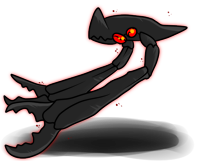
Armoury Demon
Affiliation: Dark
An armoury demon is vaguely crab-shaped with two oversized claws and no other limbs. It can hover up to a few feet above the ground, though it prefers to stay at knee level when attacking. At the size of a serving platter, it is among the largest of the dark-affiliated demons, with only the dark and devouring demons being larger.
Like most dark-affiliated demons, an armoury demon relies more on persistence than on brute force. However, its claws pack a powerful punch and can break bones. Fighting back is challenging, as the armor that gives the armoury demon its name is very strong, with even young armoury demons being unaffected by trampling. Unlike the crabs it superficially resembles, an armoury demon never needs to shed its armor, as the armor grows as it does.
An armoury demon is often a bodyguard and advance scout for a swarm of other dark-affiliated demons and so is frequently an early warning sign of an invasion. They’re also perfectly capable of causing trouble on their own. Armoury demons like to pinch a sleeping creature and let something else take the blame. They’ll play this trick on singularities, baenalkin, and even other demons. Luckily, armoury demons prefer easy targets and, unless in the middle of a fight, can often be persuaded that a chosen victim isn’t worth the trouble.
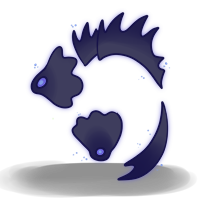
Auknal Demon
Affiliation: Water
Ranging from the size of a goldfish to the size of the “one that got away” (anglers will know what I mean), the auknal demon is the smallest of the water-affiliated demons. Frequently found in ponds near areas infested by demons, auknal demons can be mistaken for normal fish if the water is cloudy enough to make it hard to tell that neither of the two heads is actually attached to the body. Auknal demons are shy and skittish, so one of the two heads is always keeping watch. They prefer to avoid confrontation, but will spray scalding hot water if provoked.
Auknal demons are harmless on their own, but often a warning sign of a greater problem. A pond that has auknal demons one week could have gulper demons by the end of the month, or worse. There is, regrettably, no easy way to deal with an auknal demon infestation, though some water mages have reported being able to occasionally relocate a few using a sufficiently large bubble of water.
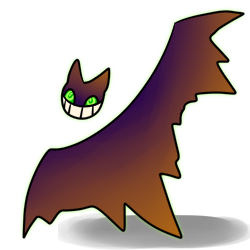
Bat Demon
Affiliation: Thirteenth Year
Bat demons are named for the bats they resemble, though there’s no chance of confusion with the mundane variety. In addition to displaying an orange-to-purple gradient not found on ordinary bats, they are startlingly large. The novelty blankets one can sometimes find for sale in the market are actually slightly smaller than life-size.
Like other Thirteenth Year demons, bat demons are more mischievous than harmful. They like to dive-bomb humans, creatures, and other demons, but usually won’t follow up a good scare with a painful bite. They can also be bribed into not attacking. To walk about on Thirteenth Year nights unbothered by malevolent, tattered bedsheets, simply carry along a handful of candy. Just be warned that this can lead to being attacked by a flock of candee demons instead, and at least bat demons don’t leave bruises when they dive-bomb you.
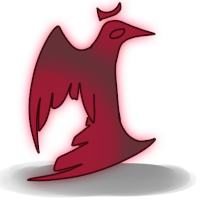
Bird Demon
Affiliation: Edgelands
Bird demons were originally the rarest and most elusive of the Edgelands demons, but have steadily grown in numbers over the years. Now, it’s hard to go more than a few steps past an Infinity Pillar without attracting the attention of at least one ruby-eyed observer. Bird demons are roughly ravne-sized, with the red comb resembling a crown that might catch the attention of a valravn. They’re scavengers, not hunters, but the constant observation wears on the nerves more than an attack would. Bird demons are mostly solitary, but will form flocks to intimidate a vile demon or other threat.
Bird demons can sing and will mimic other birds and any other interesting sounds they encounter, though even their best attempts wind up distorted. Rumor has it that a few can imitate human speech well enough to almost be understood, though these reports come from travelers who have strayed much too far into the Edgelands and should be taken with a grain (if not a pound) of salt.
Bird demons will sometimes pick one particular human to follow through the Edgelands. They have been known to warn their chosen human about threats, but they are just as likely to lead someone into danger or toward a threat the bird demon wants them to deal with. One must never mistake curiosity for altruism.
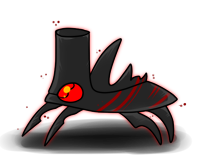
Buzzer Demon
Affiliation: Dark
The buzzer demon is one of the smallest known demons, second only to the candee demon. It’s frequently mistaken for a mundane – if oversized and rather spiky – insect at a casual glance. They usually travel in swarms, so a lone buzzer demon generally has a few dozen of its friends close by and ready to defend it. They are also known to serve as protectors for large swarms of insects, swooping in if a member is threatened.
The bite of a buzzer demon leads to itchy welts, but poses no great harm to anything larger than a shink. Getting caught by a whole swarm is unpleasant, but rarely fatal. However, its incessant buzz is far worse than its bite. One buzzer demon is a mild annoyance, something like a junebug with ambitions, but a swarm of buzzer demons produces enough noise to make cicadas jealous. Even the most even-tempered mage will be drawing up plans for a bigger, better flyswatter after a few minutes. Most creatures leave buzzer demons alone, but toads will sometimes try to eat them. This never ends well for the toad.
Amusingly, buzzer demons even annoy other demons. A skilled, observant, and above all careful mage might be able to make use of this, but should keep in mind that one possible outcome is being chased by a swarm of buzzer demons in addition to whatever you were trying to distract.

Candee Demon
Affiliation: Thirteenth Year
The smallest known demon, a candee demon gives the impression of a piece of hard candy that has used its wrapper-edge wings to take to the air in search of mischief. Like all Thirteenth Year demons, it’s more of an annoyance than a threat. It doesn’t bite, but doesn’t need to, as its erratic flight, hard body, and tendency to travel in flocks mean that most encounters end with painful bruises. Candee demons are drawn to sweet things and will use their thin, clawed legs to snatch treats out of a magi’s hand. Attempting to retaliate is unwise, as most magical attacks ricochet off the hard, round body in unexpected directions and usually cause more harm to the caster than to the candee demon.
Surprisingly strong, candee demons can carry off a caramel apple that is both many times larger and many times heavier than they are. They are especially fond of chocolate and can sometimes be distracted by a thrown chocolate bar. Throwing the chocolate bar at another demon may be tempting, but isn’t worth the risk. The most likely outcome is having two annoyed demons in hot pursuit.
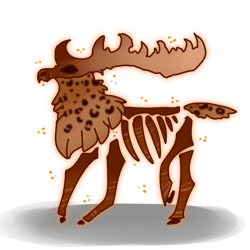
Carrion Demon
Affiliation: Stone
Carrion demons are the size of a large deer and lack the heavy armor of other stone-affiliated demons, but given that they’re effectively animated skeletons, they don’t really need it. The rather ominous name likely refers either to their skeletal appearance or to their habit of scavenging their meals. Stronger than they look, they can survive damage that would kill other demons, with three-legged carrion demons being a common sight near the castle.
Carrion demons are usually harmless unless provoked, but are hard to stop once they start charging. The best chance of escape is to lead the carrion demon into something that will entangle the oversized antlers, as they are not shed annually and are the one weak point.
Like the deer they resemble, carrion demons are extremely fond of human gardens. They might not be able to eat or even taste the contents, but this doesn’t stop them from sampling anything the garden has to offer. Carrion demons are even more destructive than ordinary deer, as they will often trample whole gardens out of apparent frustration at not finding anything they can eat. Luckily, they are easily deterred by a few spells or, in a pinch, wire netting.
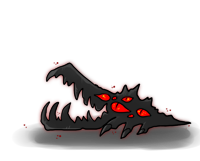
Chaser Demon
Affiliation: Dark
Chaser demons look as though they couldn’t chase down anything faster than an arthritic snail. However, what they lack in speed, they make up for in persistence. Chaser demons don’t need to eat, sleep, or breathe, can hold a grudge for decades, and are not stopped by running water. They’re only about ankle-high, but much of their small body is made up of mouth and very sharp teeth, with a jaw strength equal to that of the devourer demon. Occasionally, carrion demons or other skeletal demons will have one or more chaser demons attached to them, which seemingly does nothing but irritate everyone involved.
In a pinch, one can try distracting another demon by leading it into the path of a chaser demon, but beware. The most likely outcome is that one will then have two grudge-holding demons in pursuit and the second one won’t have the chaser demon’s physical limitations.
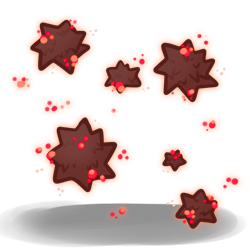
Confetti Demon
Affiliation: Fire
Despite looking like a swarm of individual entities, a confetti demon is actually one consciousness split into multiple pieces. A confetti demon always consists of at least two pieces, as a single piece taken too far from the rest will quickly dissipate. There doesn’t seem to be an upper limit, though confetti demons with more than a dozen pieces seem to have trouble controlling them all. The optimal number of parts seems to be about six – small enough to be easily controlled, but large enough that losing a part isn’t a death sentence. Confetti demons lack the sheer firepower of other fire-affiliated demons, but make up for that with greater maneuverability. The ever-changing dance of the individual parts can hypnotize the unwary just as well as any life-affiliated demon can.
Confetti demons, especially the smaller ones, are sometimes drawn to human-made fires, like campfires. If this happens, retreat to a safe distance and wait. Confetti demons won’t attack someone who isn’t posing an immediate threat, and they will usually leave after a few minutes once they’ve had a chance to dance in the flames.
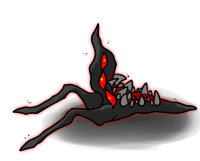
Crawler Demon
Affiliation: Dark
Small and low-slung with short, stubby legs, the crawler demon is by necessity an ambush predator. Groups of these will sometimes bury themselves on well-used paths to trap the unwary with their sharp spines, which can pierce through most shoes. Once the jaw-back snaps closed, it is nearly impossible to pry open again. As lurking crawler demons are surprisingly hard to see, travelers are advised to carry a walking stick along for poking at suspicious patches of disturbed earth. This is also a good way to find the far more dangerous grabber demon before it sinks its jaws into your leg.
Crawler demons will occasionally team up with chaser demons to catch prey. Anything with a chaser demon closing in won’t be too careful about where it steps, and then won’t be able to escape before the chaser demon catches it. This occasionally backfires when another demon is the target, especially if it hovers or is too heavily armored to notice the crawler demon’s spines.
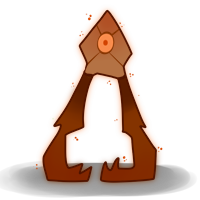
Crystalline Demon
Affiliation: Stone
Crystalline demons are among the tallest of the demons, though most of that height is leg. They move with a curious halting motion that makes them resemble a giant’s wind-up toy or a poorly-animated construct. Much like the average wind-up toy, once they start moving, they will keep moving in a straight line until they run into an obstacle, then batter themselves against it until either it or they fall over.
Crystalline demons are as hard as the stone they resemble. Their battle strategy is to wait until an opponent has exhausted itself battering against the crystalline demon, then fall over on it. This technique is useless against armoury demons, which levitate, but since even armoury demon claws can’t crack a crystalline demon’s skin, battles between the two generally end in stalemates. Afterwards, the two either head off in other directions as though that had been the plan all along or look for some nearby object or creature on which they can take out their frustrations. Observers should be ready to quickly retreat to a safe distance.
Crystalline demons are the standard earth demon brown, but the small diamond-shaped body occasionally has highlights of other colors. One can occasionally find small chips of the stone-like body where a fight has taken place, especially if an armoury demon was involved. The chips resemble colored glass, but are far stronger. The pieces can – and this is unusual, so be warned – safely be collected and displayed without corrupting their surroundings or harming anyone. It is also not true that these chips can grow into other crystalline demons under the right conditions, no matter what certain persistent rumors, folk stories, and old wives’ tales would have you believe.
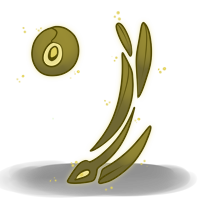
Cuspid Demon
Affiliation: Light
The cuspid demon seems at first to be poorly named, as it doesn’t even have a mouth, let alone teeth to bite with. The name refers to the many fragments of the body, each of which is razor-sharp. The secondary set of eyes in one of the fragments allows the cuspid demons to coordinate the various pieces to make a “mouth” that would be the envy of any vile demon. Both sets of eyes are needed to coordinate the other pieces, so the best way to render a cuspid demon harmless is to find a way to create a second diversion that forces it to split its attention.
Surprisingly, the cuspid demon prefers to use its “teeth” to eat plants, rather than meat, which just means it wipes out crops rather than livestock. It also loves gardens. Given its smaller size (about the size of a wasp’s nest when all the pieces are gathered together) and its habit of resting under plants before it feeds, it poses a hazard for the unwary gardener. It’s not aggressive, but stepping on one means that everyone involved (including the demon) is about to have a very bad day. Any attack that breaks the skin, especially if any glass-like splinters are left behind, requires immediate medical treatment to avoid infection.
After a known cuspid demon infestation, check the garden carefully for any splinters broken off from a larger fragment. These splinters should be disposed of responsibly, as they cannot be used for tools or potion ingredients. Unlike crystalline demon shards, they are dangerous. Besides the risk of infected cuts, the splinters may attract a cuspid demon looking for more shards to add to its body.

Armoury Demon
Affiliation: Dark
An armoury demon is vaguely crab-shaped with two oversized claws and no other limbs. It can hover up to a few feet above the ground, though it prefers to stay at knee level when attacking. At the size of a serving platter, it is among the largest of the dark-affiliated demons, with only the dark and devouring demons being larger.
Like most dark-affiliated demons, an armoury demon relies more on persistence than on brute force. However, its claws pack a powerful punch and can break bones. Fighting back is challenging, as the armor that gives the armoury demon its name is very strong, with even young armoury demons being unaffected by trampling. Unlike the crabs it superficially resembles, an armoury demon never needs to shed its armor, as the armor grows as it does.
An armoury demon is often a bodyguard and advance scout for a swarm of other dark-affiliated demons and so is frequently an early warning sign of an invasion. They’re also perfectly capable of causing trouble on their own. Armoury demons like to pinch a sleeping creature and let something else take the blame. They’ll play this trick on singularities, baenalkin, and even other demons. Luckily, armoury demons prefer easy targets and, unless in the middle of a fight, can often be persuaded that a chosen victim isn’t worth the trouble.

Auknal Demon
Affiliation: Water
Ranging from the size of a goldfish to the size of the “one that got away” (anglers will know what I mean), the auknal demon is the smallest of the water-affiliated demons. Frequently found in ponds near areas infested by demons, auknal demons can be mistaken for normal fish if the water is cloudy enough to make it hard to tell that neither of the two heads is actually attached to the body. Auknal demons are shy and skittish, so one of the two heads is always keeping watch. They prefer to avoid confrontation, but will spray scalding hot water if provoked.
Auknal demons are harmless on their own, but often a warning sign of a greater problem. A pond that has auknal demons one week could have gulper demons by the end of the month, or worse. There is, regrettably, no easy way to deal with an auknal demon infestation, though some water mages have reported being able to occasionally relocate a few using a sufficiently large bubble of water.

Bat Demon
Affiliation: Thirteenth Year
Bat demons are named for the bats they resemble, though there’s no chance of confusion with the mundane variety. In addition to displaying an orange-to-purple gradient not found on ordinary bats, they are startlingly large. The novelty blankets one can sometimes find for sale in the market are actually slightly smaller than life-size.
Like other Thirteenth Year demons, bat demons are more mischievous than harmful. They like to dive-bomb humans, creatures, and other demons, but usually won’t follow up a good scare with a painful bite. They can also be bribed into not attacking. To walk about on Thirteenth Year nights unbothered by malevolent, tattered bedsheets, simply carry along a handful of candy. Just be warned that this can lead to being attacked by a flock of candee demons instead, and at least bat demons don’t leave bruises when they dive-bomb you.

Bird Demon
Affiliation: Edgelands
Bird demons were originally the rarest and most elusive of the Edgelands demons, but have steadily grown in numbers over the years. Now, it’s hard to go more than a few steps past an Infinity Pillar without attracting the attention of at least one ruby-eyed observer. Bird demons are roughly ravne-sized, with the red comb resembling a crown that might catch the attention of a valravn. They’re scavengers, not hunters, but the constant observation wears on the nerves more than an attack would. Bird demons are mostly solitary, but will form flocks to intimidate a vile demon or other threat.
Bird demons can sing and will mimic other birds and any other interesting sounds they encounter, though even their best attempts wind up distorted. Rumor has it that a few can imitate human speech well enough to almost be understood, though these reports come from travelers who have strayed much too far into the Edgelands and should be taken with a grain (if not a pound) of salt.
Bird demons will sometimes pick one particular human to follow through the Edgelands. They have been known to warn their chosen human about threats, but they are just as likely to lead someone into danger or toward a threat the bird demon wants them to deal with. One must never mistake curiosity for altruism.

Buzzer Demon
Affiliation: Dark
The buzzer demon is one of the smallest known demons, second only to the candee demon. It’s frequently mistaken for a mundane – if oversized and rather spiky – insect at a casual glance. They usually travel in swarms, so a lone buzzer demon generally has a few dozen of its friends close by and ready to defend it. They are also known to serve as protectors for large swarms of insects, swooping in if a member is threatened.
The bite of a buzzer demon leads to itchy welts, but poses no great harm to anything larger than a shink. Getting caught by a whole swarm is unpleasant, but rarely fatal. However, its incessant buzz is far worse than its bite. One buzzer demon is a mild annoyance, something like a junebug with ambitions, but a swarm of buzzer demons produces enough noise to make cicadas jealous. Even the most even-tempered mage will be drawing up plans for a bigger, better flyswatter after a few minutes. Most creatures leave buzzer demons alone, but toads will sometimes try to eat them. This never ends well for the toad.
Amusingly, buzzer demons even annoy other demons. A skilled, observant, and above all careful mage might be able to make use of this, but should keep in mind that one possible outcome is being chased by a swarm of buzzer demons in addition to whatever you were trying to distract.

Candee Demon
Affiliation: Thirteenth Year
The smallest known demon, a candee demon gives the impression of a piece of hard candy that has used its wrapper-edge wings to take to the air in search of mischief. Like all Thirteenth Year demons, it’s more of an annoyance than a threat. It doesn’t bite, but doesn’t need to, as its erratic flight, hard body, and tendency to travel in flocks mean that most encounters end with painful bruises. Candee demons are drawn to sweet things and will use their thin, clawed legs to snatch treats out of a magi’s hand. Attempting to retaliate is unwise, as most magical attacks ricochet off the hard, round body in unexpected directions and usually cause more harm to the caster than to the candee demon.
Surprisingly strong, candee demons can carry off a caramel apple that is both many times larger and many times heavier than they are. They are especially fond of chocolate and can sometimes be distracted by a thrown chocolate bar. Throwing the chocolate bar at another demon may be tempting, but isn’t worth the risk. The most likely outcome is having two annoyed demons in hot pursuit.

Carrion Demon
Affiliation: Stone
Carrion demons are the size of a large deer and lack the heavy armor of other stone-affiliated demons, but given that they’re effectively animated skeletons, they don’t really need it. The rather ominous name likely refers either to their skeletal appearance or to their habit of scavenging their meals. Stronger than they look, they can survive damage that would kill other demons, with three-legged carrion demons being a common sight near the castle.
Carrion demons are usually harmless unless provoked, but are hard to stop once they start charging. The best chance of escape is to lead the carrion demon into something that will entangle the oversized antlers, as they are not shed annually and are the one weak point.
Like the deer they resemble, carrion demons are extremely fond of human gardens. They might not be able to eat or even taste the contents, but this doesn’t stop them from sampling anything the garden has to offer. Carrion demons are even more destructive than ordinary deer, as they will often trample whole gardens out of apparent frustration at not finding anything they can eat. Luckily, they are easily deterred by a few spells or, in a pinch, wire netting.

Chaser Demon
Affiliation: Dark
Chaser demons look as though they couldn’t chase down anything faster than an arthritic snail. However, what they lack in speed, they make up for in persistence. Chaser demons don’t need to eat, sleep, or breathe, can hold a grudge for decades, and are not stopped by running water. They’re only about ankle-high, but much of their small body is made up of mouth and very sharp teeth, with a jaw strength equal to that of the devourer demon. Occasionally, carrion demons or other skeletal demons will have one or more chaser demons attached to them, which seemingly does nothing but irritate everyone involved.
In a pinch, one can try distracting another demon by leading it into the path of a chaser demon, but beware. The most likely outcome is that one will then have two grudge-holding demons in pursuit and the second one won’t have the chaser demon’s physical limitations.

Confetti Demon
Affiliation: Fire
Despite looking like a swarm of individual entities, a confetti demon is actually one consciousness split into multiple pieces. A confetti demon always consists of at least two pieces, as a single piece taken too far from the rest will quickly dissipate. There doesn’t seem to be an upper limit, though confetti demons with more than a dozen pieces seem to have trouble controlling them all. The optimal number of parts seems to be about six – small enough to be easily controlled, but large enough that losing a part isn’t a death sentence. Confetti demons lack the sheer firepower of other fire-affiliated demons, but make up for that with greater maneuverability. The ever-changing dance of the individual parts can hypnotize the unwary just as well as any life-affiliated demon can.
Confetti demons, especially the smaller ones, are sometimes drawn to human-made fires, like campfires. If this happens, retreat to a safe distance and wait. Confetti demons won’t attack someone who isn’t posing an immediate threat, and they will usually leave after a few minutes once they’ve had a chance to dance in the flames.

Crawler Demon
Affiliation: Dark
Small and low-slung with short, stubby legs, the crawler demon is by necessity an ambush predator. Groups of these will sometimes bury themselves on well-used paths to trap the unwary with their sharp spines, which can pierce through most shoes. Once the jaw-back snaps closed, it is nearly impossible to pry open again. As lurking crawler demons are surprisingly hard to see, travelers are advised to carry a walking stick along for poking at suspicious patches of disturbed earth. This is also a good way to find the far more dangerous grabber demon before it sinks its jaws into your leg.
Crawler demons will occasionally team up with chaser demons to catch prey. Anything with a chaser demon closing in won’t be too careful about where it steps, and then won’t be able to escape before the chaser demon catches it. This occasionally backfires when another demon is the target, especially if it hovers or is too heavily armored to notice the crawler demon’s spines.

Crystalline Demon
Affiliation: Stone
Crystalline demons are among the tallest of the demons, though most of that height is leg. They move with a curious halting motion that makes them resemble a giant’s wind-up toy or a poorly-animated construct. Much like the average wind-up toy, once they start moving, they will keep moving in a straight line until they run into an obstacle, then batter themselves against it until either it or they fall over.
Crystalline demons are as hard as the stone they resemble. Their battle strategy is to wait until an opponent has exhausted itself battering against the crystalline demon, then fall over on it. This technique is useless against armoury demons, which levitate, but since even armoury demon claws can’t crack a crystalline demon’s skin, battles between the two generally end in stalemates. Afterwards, the two either head off in other directions as though that had been the plan all along or look for some nearby object or creature on which they can take out their frustrations. Observers should be ready to quickly retreat to a safe distance.
Crystalline demons are the standard earth demon brown, but the small diamond-shaped body occasionally has highlights of other colors. One can occasionally find small chips of the stone-like body where a fight has taken place, especially if an armoury demon was involved. The chips resemble colored glass, but are far stronger. The pieces can – and this is unusual, so be warned – safely be collected and displayed without corrupting their surroundings or harming anyone. It is also not true that these chips can grow into other crystalline demons under the right conditions, no matter what certain persistent rumors, folk stories, and old wives’ tales would have you believe.

Cuspid Demon
Affiliation: Light
The cuspid demon seems at first to be poorly named, as it doesn’t even have a mouth, let alone teeth to bite with. The name refers to the many fragments of the body, each of which is razor-sharp. The secondary set of eyes in one of the fragments allows the cuspid demons to coordinate the various pieces to make a “mouth” that would be the envy of any vile demon. Both sets of eyes are needed to coordinate the other pieces, so the best way to render a cuspid demon harmless is to find a way to create a second diversion that forces it to split its attention.
Surprisingly, the cuspid demon prefers to use its “teeth” to eat plants, rather than meat, which just means it wipes out crops rather than livestock. It also loves gardens. Given its smaller size (about the size of a wasp’s nest when all the pieces are gathered together) and its habit of resting under plants before it feeds, it poses a hazard for the unwary gardener. It’s not aggressive, but stepping on one means that everyone involved (including the demon) is about to have a very bad day. Any attack that breaks the skin, especially if any glass-like splinters are left behind, requires immediate medical treatment to avoid infection.
After a known cuspid demon infestation, check the garden carefully for any splinters broken off from a larger fragment. These splinters should be disposed of responsibly, as they cannot be used for tools or potion ingredients. Unlike crystalline demon shards, they are dangerous. Besides the risk of infected cuts, the splinters may attract a cuspid demon looking for more shards to add to its body.
This post has been edited 1 times. Last edited on 10-31-2025 13:49:27.
Need site currency? Try playing with my hundreds of companions here. Companions may be played with once per hour (total, not per user). Check back later if nothing shows up.
Please note that I am not an admin, coder, or moderator. I've just been here forever. Ezriaphiel and Iaophiel are the two people in charge of the site.
Still on AO3 here - Forest of Mirrors, Dragon Cave, MagiStream, and original fiction.
Please note that I am not an admin, coder, or moderator. I've just been here forever. Ezriaphiel and Iaophiel are the two people in charge of the site.
Still on AO3 here - Forest of Mirrors, Dragon Cave, MagiStream, and original fiction.
Posted 09-08-2022 17:20:59
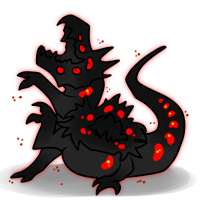
Dark Demon
Affiliation: Dark
The dark demon is one of the original eight types to infest the world. It resembles a wingless dragon with far too many red eyes, but instead of a dragon’s fire, it exudes a black miasma from its mouth that can do more damage than a bite from its sharp jaws. Among the largest of the dark demons (second only to the devourer demon) and very aggressive, it should be strictly left alone.
Dark demons were the first type to move beyond simply mirroring their opponent and try to selectively take on aspects of what they faced to better win battles. This explains both why there are so many types of dark-affiliated demon and, because of the inevitable learning curve, why so many of them look so strange.
Dark demons sometimes gather flocks of other dark-affiliated demons around them, especially those that can fly or levitate. Depending on the dark demon’s mood, these can be valuable assistants or just a way of always having snacks on hand.
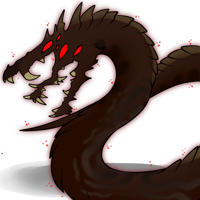
Devourer Demon (Boss)
Affiliation: Dark
The serpentine devourer demon is the largest and most fearsome of the boss demons, being large enough to swallow all but the largest battle champions. It will eat anything it can fit either of its two mouths around, including other demons and especially Edgelands-affiliated demons. Humans are no challenge whatsoever. We can only hope that it is either immune to Edgelands corruption or mutates into one of the known types. The alternative is a larger and entirely more terrifying variety of boss demon lurking just beyond the Infinity Pillars.
If a devourer demon shows up while you are battling another demon, flee the fight. It will make short work of your opponent, yes, but then it will turn on you.
Some of the older castle residents have noticed a possible resemblance between the devourer demon and the dreaded Tathoes. This is, one hopes, either an imagined resemblance or a purely coincidental one.
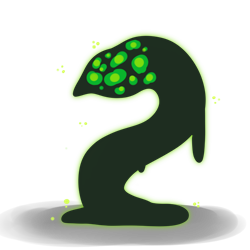
Faint Demon
Affiliation: Life
At first glance, the faint demon seems harmless. It lacks claws and teeth, and though vaguely serpentine in appearance, it’s too small and weak to pose a threat if it decides to coil around something. However, a faint demon is far more dangerous than it looks and its small size only makes it more so.
Of all the life-affiliated demons, the faint demon is the best at disorienting opponents. It’s hard to look directly at it without feeling dizzy enough to pass out, and prolonged eye contact can knock a person or creature out for hours. As the effect is always active and is not under the faint demon’s control, the faint demon is actually one of the most dangerous demons, especially since it’s small enough to frequently go unnoticed until it’s too late.
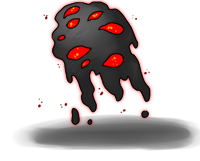
Feral Amorphous Demon
Affiliation: Dark
Feral amorphous demons are, so far as is known, the only type of demon to actually be a transformed creature. These demons are the reason why there are so many warnings about getting rid of unwanted amorphouses. Careless disposal, especially of an adult, will frequently lead to the creation of a feral amorphous demon.
Larger and far more dangerous than the normal variety, though still one of the smaller demons, feral amorphous demons are highly aggressive and perpetually hungry. They will attack and engulf whatever animal they come across, though luckily they can no longer take on the properties of what they consume. Be aware that feral amorphous demons cannot be rehabilitated. Attempts to do so never end well for mage or amorphous.
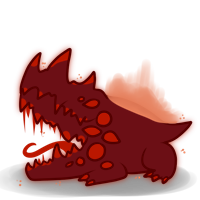
Fire Demon
Affiliation: Fire
The fire demon is one of the original eight types to infest the world. It starts fires wherever it goes without even needing to breathe fire, though it can also breathe fire a startlingly long distance. Be warned that though a fire demon may be slow-moving, the jet of fire it breathes out is much harder to outrun.
Supposedly, it’s possible to fry an egg on its back, though it’s a mystery how this was discovered or why anyone would want to try. To (with luck) state the obvious, getting close enough to a fire demon to crack an egg on its back is unwise. Also, the fried egg will be inedible at best and lethal at worst. Eating anything that has come into contact with a demon is never a good idea.
Fire demons have a long-standing rivalry with water demons. To answer one perpetual question, when a fire demon meets a water demon, the result is clouds of scalding steam and two very annoyed demons.
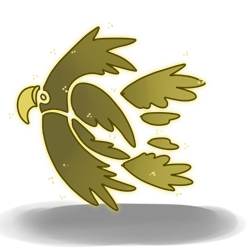
Fish Demon
Affiliation: Light
Fish demons aren’t aquatic, but do like to drift near the surface of lakes and ponds. This greatly annoys any resident auknal demons, who will use both heads to shoot water jets to try to knock the fish demon out of the sky. As water attacks work about as well on the fish demon as light-based attacks do on the auknal demon, all that results for both is annoyance and frustration.
Fish demons look startlingly large, but most of this is frilly fin. When they draw in their fins to escape the notice of a larger demon, it quickly becomes clear that they’re really closer to auknal-sized.
When in the mood, fish demons will sometimes dance over the surface of the water. This dazzling display can – a rarity for demons – be safely watched from a distance, as fish demons save their enmity for auknal demons. In fact, they seem to appreciate being admired. Just keep an eye out for other demons and be sure not to make any sudden threatening movements.
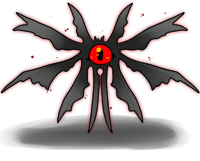
Flier Demon
Affiliation: Dark
The flier demon has one large red eye and eight small wings. The extra wings don’t do much for maneuverability, so it has a habit of flying into things. It’s of average size for dark-affiliated demons – large enough to startle, but not large enough to easily knock a person over, no matter how hard it tries. Its preferred battle strategy is to dive-bomb opponents until they either give up or find a way to ground it.
Flier demons may be more of a nuisance than a threat, but it’s still wise to be wary around them. Even other demons find the flier demon annoying and will use their own attacks to try to knock it out of the air. If that doesn’t work, they’ll go for an easier target, like a nearby mage.
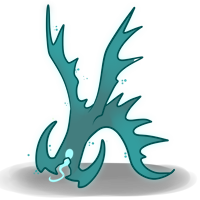
Flighter Demon
Affiliation: Wind
Roughly avian in shape (if you squint and ignore the spikes, especially the two backward-curving head spikes), the flighter demon is colloquially known as “windhawk” for its habit of soaring on wind currents it conjures up and then swooping down on unsuspecting prey. In place of claws, it catches its quarry with thin currents of wind so concentrated as to be needle-sharp. Flighter demons are not particularly aggressive and prefer prey they can carry, so since the largest are about eagle-sized, they rarely attack humans unless provoked. Having one hover nearby at about eye level can be disconcerting, but the only real danger is to any small, loose objects you might be carrying. It’s best to let them take whatever catches their fancy, as a bite from their strong jaws is extremely painful.
Flighter demons might not view humans as food, but some have learned to view certain travelers as a source of food. As they like it when someone else has done part of the work of subduing a potential meal, they sometimes follow a human with a battle champion creature around in hopes of benefiting from a battle.
Flighter demons particularly like to hunt Edgelands-corrupted demons and are one of the few types to venture beyond the safety of the Infinity Pillars. However, they should not be relied upon as a potential source of aid, as they are easy prey for vile demons and thus remain rare in the Edgelands.

Flock Demon
Affiliation: Life
A flock demon is, as the name suggests, composed of two or more separate entities. A singleton can survive as long as the head and at least one wing is intact, but will be vulnerable until it can find another collective to join with. A healthy flock demon will contain between two and twelve separate entities, with the larger ones eventually splitting into two or more smaller flock demons.
Multiple flock demons will often join into one massive flock to defeat a common foe, then separate when the threat has passed and the individual collectives begin to disagree. Whether individual entities swap flocks in the process is unknown. While individual entities in a collective are roughly the same size (the heads range from sparrow-sized to crow-sized, depending on age and health), a temporary flock often contains a whole range of sizes.
Flock demons defend themselves through minor illusion spells. Each individual entity distorts vision in a slightly different way, which magnifies the overall disorienting effect. The effect, amusingly, also works on other flock demons and is often used to resolve territorial disputes.
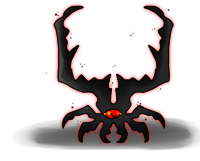
Grabber Demon
Affiliation: Dark
The grabber demon is small and roughly spider-shaped, except for the giant pincer-jaws on its back that give the impression of having been stolen from something far larger. The jaws can be opened wide enough for each half to lie flat on the ground, and then instantaneously snap shut around anything that touches them.
To catch prey, grabber demons bury themselves in sand or soft soil and wait for something to step on them. The older and more successful ones know enough to find a way to hide the giant jaws from view, but the younger ones rely on the prey being distracted by a greater threat.
If traveling in a place where grabber demons are known to lurk, wear thick boots, carry a long, sturdy stick, and be wary of patches of disturbed earth or sand. Luckily, the jaws will close around anything they encounter and are slow to reopen, so it’s possible to escape a grabber demon by blocking the jaws with, say, a large piece of wood and escaping before it can recover. If caught, try to get your foot out of the shoe before the jaws cut through it and then (carefully) run for safety. The grabber demon won’t chase you, but there are likely crawler demons buried nearby.
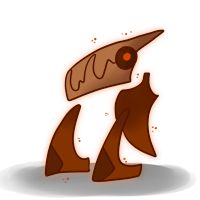
Guardian Demon
Affiliation: Stone
The guardian demon is the second-smallest of the stone-affiliated demons, though not actually small, as it’s tall enough to look the average human in the eye. It often serves as a guard for smaller, weaker demons – usually dark-affiliated. If no other demons are around, it will adopt anything small and seemingly helpless that doesn’t bolt at the sight of it. Since most animals have the sense to flee from demons, a lonely guardian demon often adopts rocks, branches, or the occasional stray amorphous. Those near human settlements often collect lost toys.
Harming a guardian demon’s charge, whether demon, amorphous, or inanimate object, will earn the demon’s immediate and terrible wrath. A kick from one of its legs will break bones and a bite from its jaws (which make up most of the small head) is a serious matter.
Some mages have tried to befriend a guardian demon by giving it a sturdy toy to protect, with mixed results. Sometimes, the guardian demon accepts the gift and goes on its way, but sometimes, it decides that the human who gave the gift is a threat to its new charge. Also, because of the danger, do not attempt to bribe a guardian demon into giving up whatever small item it has decided to protect with its life, no matter how irreplaceable the item is. A guardian demon never voluntarily surrenders anything under its protection, no matter what you try to give it in exchange.
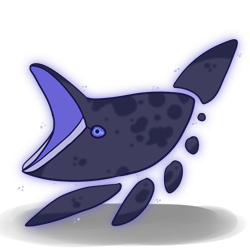
Gulper Demon
Affiliation: Water
The gulper demon is the largest known demon, though, thankfully, smaller than the variety of whale it resembles. Its preferred strategy is to attempt to overwhelm its opponents by shooting jets of water, though it may also try to eat smaller, weaker battle champions. (with mixed success, as it’s not really designed to swallow anything much larger than a buzzer demon). Gulper demons don’t need to eat, but will swallow flocks of buzzer demons or candee demons with apparent enjoyment.
Gulper demons are surprisingly docile and will not attack unless severely provoked. They are most often found near large bodies of water, with a substantial population choosing to drift above the ocean. Gulper demons don’t usually seek out the company of other demons (except for the flock of buzzer demons they’re about to devour), but will watch fish demons dance with every sign of enjoyment.
This post has been edited 1 times. Last edited on 10-31-2025 13:52:04.
Need site currency? Try playing with my hundreds of companions here. Companions may be played with once per hour (total, not per user). Check back later if nothing shows up.
Please note that I am not an admin, coder, or moderator. I've just been here forever. Ezriaphiel and Iaophiel are the two people in charge of the site.
Still on AO3 here - Forest of Mirrors, Dragon Cave, MagiStream, and original fiction.
Please note that I am not an admin, coder, or moderator. I've just been here forever. Ezriaphiel and Iaophiel are the two people in charge of the site.
Still on AO3 here - Forest of Mirrors, Dragon Cave, MagiStream, and original fiction.
Posted 09-08-2022 17:24:42
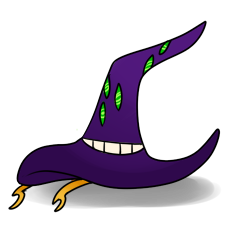
Hat Demon
Affiliation: Thirteenth Year
Of the Thirteenth Year demons, the hat demon feels the most like someone’s idea of a practical joke. As the name suggests, it looks like a perfectly ordinary pointed witch’s hat, if one disregards the green jewel-like eyes and the toothy grin. If one got into a pile of the replica hats sold in the marketplace every Thirteenth Year, it would be hard to figure out which one was the genuine article, at least until one hat started moving under its own power and attacking the other hats. Hat demons hate these lookalikes and attempt to destroy every one they see, though they have yet to figure out that teeth are more effective than trying to jump up and down on a hat.
The hat demon hunts by crawling up to a path, retracting its legs (which look like the cords tied under your chin to keep a hat on), and waiting for someone to try on the perfectly ordinary witch’s hat. As it can’t stop grinning and wriggling around at the thought of fooling someone, few people are oblivious enough to fall for the rather obvious trap. The hat demon will also try to envelop potential opponents, but most battle champions are large enough to make this a less-than-viable strategy.
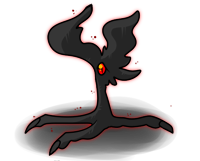
Hopper Demon
Affiliation: Dark
Most dark-affiliated demons look a little ridiculous, but hopper demons are perhaps the most absurd of all. They resemble an amorphous trying to imitate a crow without ever having seen one, or perhaps some mage’s attempt to assemble a bird familiar out of one red eye, two small wings, and one giant clawed foot.
Be warned, though, that hopper demons are less harmless than they appear. Yes, the nearly useless wings mean that the only way they can attack from the ground is to propel themselves forward with the back claw and try to lash out with the other two. However, they can, with considerable effort or the aid of other demons, climb up to a high branch and perch awkwardly there until something interesting wanders by. Having one drop on your head is no joke.
Hopper demons, despite not having a mouth, can still caw surprisingly loudly. They use this talent to attract the attention of nearby demons to a potential threat or an easy target. Luckily, because they hop extremely slowly and are easily distracted, it’s usually possible to outrun one before reinforcements arrive.
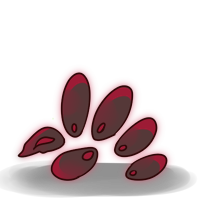
Incher Demon
Affiliation: Edgelands
Like vile demons, incher demons may be a result of the Edgelands corrupting another demon – ovid, perhaps, or confetti, or another demon with the same body plan. They have been compared to a demonic bunch of grapes, and although the individual components are closer in size to a decent-sized squash, with some being more the size of the one zucchini that escaped the gardener’s notice all summer, it’s not a bad comparison. The shape is right, at least.
Incher demons can only move at a slow crawl across the ground – hence the name – and must rely either on scavenging or on unwary travelers being too dazzled by the other strange sights beyond the Infinity Pillars to notice what is creeping up on them. Luckily, incher demons are easily driven off with a few pokes from a walking stick. Just be careful not to let one touch bare skin. Not all Edgelands demons can corrupt with a touch, but many can, and it’s impossible to tell at a glance which is which.
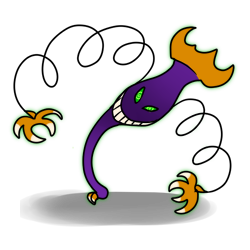
Jester Demon
Affiliation: Thirteenth Year
The jester demon is the most mischievous of the Thirteenth Year demons, which may spring (if you’ll excuse the pun) from its resemblance to a jack-in-the-box that has escaped its box. It likes to jump out at people, snatch something out of their hands, and then bound away before they’ve recovered enough to retaliate. If the target is empty-handed, the jester demon will wrap its arms around the person instead and tangle them up so that they will fall over when they try to move.
Making someone fall in this way seems to be the height of humor for the jester demon. After spending a few minutes springing around in delight while making disturbing chuckling noises, it will bounce off in search of its next target. Stolen items are dropped at random later, as the jester demon cares more about the reaction to the theft than to what it took, so it’s best to let the jester demon have its fun and not try to confront it.
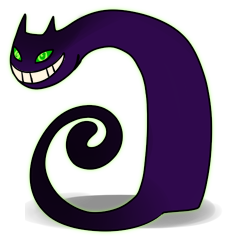
Kitty Demon
Affiliation: Thirteenth Year
Slightly larger than than its namesake, the kitty demon lurks in the shadows and is half-shadow itself. It will fade from view if spotted, with the telltale grin being the last to vanish. It can also squeeze through remarkably thin cracks, though it usually doesn’t bother to do so unless it’s escaping a threat or there’s something particularly interesting on the other side of the crack.
Kitty demons occasionally hunt the smaller dark-affiliated demons, though this seems to be more of a game than an attempt at pest control or catching a meal. The captured demon will, once it struggles loose, wait nearby until the kitty demon is ready to chase them again or, occasionally, start chasing the kitty demon.
Kitty demons are not overly aggressive and can be pacified with whatever would appeal to a normal cat. This includes toys as well as food. A surprising number of mages owe their lives to a convenient catnip mouse. However, it’s best not to try patting one, no matter how much it twines around your legs. Kitty demons appreciate a good trick and delight in frightening the unwary. Besides, they’re nowhere near as soft as they look and a bite from those teeth is no joke.
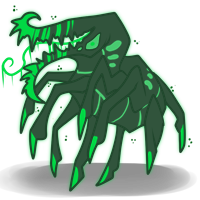
Leaf Demon
Affiliation: Leaf
The leaf demon is one of the original eight types to infest the world. Despite the name, there isn’t much plant-like about it, unless one views the long, curved jaws as being vine-like. Instead, it more closely resembles a giant (large enough to ride, if one is feeling particularly foolhardy) spider with a demonic long-jawed head.
The leaf demon’s name comes from its fondness for plants. Many leaf demons keep gardens of poison ivy so that they can rub the leaves on their skin to discourage attackers from biting them. Some leaf demons also decorate themselves with flowers, which could be as camouflage or out of vanity. They occasionally raid gardens, but do a surprising lack of harm in the process, considering their size.
Occasionally, someone will report having successfully bribed a leaf demon with flowers, but this is risky. Leaf demons prefer flowers that are toxic or extremely smelly, but they are very picky and individual tastes vary widely. Those that dislike the gift are quick to attack.
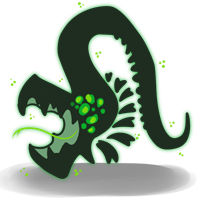
Life Demon
Affiliation: Life
The life demon is one of the original eight types to infest the world. Serpentine in appearance, it possesses oversized jaws and far too many green eyes. You would think the bite would be the most dangerous thing about it, but the head is so large and heavy and the rest of the body is so weak that the life demon has a hard time moving around. When threatened, a life demon tries to lock eyes with its attacker, as eye contact causes extreme disorientation. If that fails, it writhes around and flares out its frill in an attempt to appear larger than it is.
Life demons also have another trick – one that thankfully has not been passed on to any of the other life-affiliated demons. They can draw life from nearby plants and animals to heal themselves, though this is inefficient and requires a good amount of concentration. Large patches of dead grass, though usually a sign of insufficient water, can also indicate that a life demon has recently passed that way.
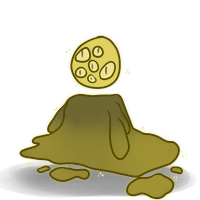
Light Demon
Affiliation: Light
The light demon is one of the original eight types to infest the world. Incredibly vain, it shuns anything that might stain it and affect its brilliant gold shine. Basically a slimy blob with a head, it leaves a golden ooze behind it, like an overgrown slug. It has a particular vendetta against ooze demons and feral amorphous demons, trying to cover up their slime trails with its own.
Light demons are drawn to glass, mirrors, and shiny objects. While they cannot be bribed, showing one a mirror and then throwing the mirror away will usually serve to distract the light demon long enough for you to escape.
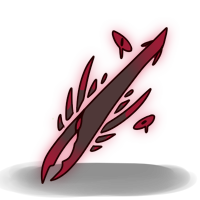
Needle Demon
Affiliation: Edgelands
The needle demon is closer in size and shape to a sword, though not one that anyone with any sense would want to wield. It gets its name from its ability to stitch and cut pieces of reality. It can join together separate paths and sever a path into pieces, so that even experienced travelers will become hopelessly lost.
Luckily for the safety of the world, the needle demon’s sewing skills only work on pieces of the landscape and only beyond the Infinity Pillars. Those that stray out of the Edgelands quickly become frustrated when their best efforts at manipulating paths only fill their mandibles with dirt.
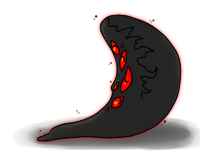
Ooze Demon
Affiliation: Dark
Ooze demons like to imitate puddles and wait to catch unwary passers-by. Luckily, they are easy to spot, as they always have at least one red eye open. Ooze are mainly a threat to clothing, as any garment they touch will be permanently stained, but the larger ones could theoretically suffocate someone. They are also hard to get rid of, as any piece of an ooze demon with at least one intact eye will grow into a new ooze demon.
Ooze demons grow as they age, though those that have become too large to find a lurking place will split into two or more smaller demons. Rumors of lake-sized ooze demons that can engulf even a devourer demon are just that – rumors.

Ovid Demon
Affiliation: Light
An ovid demon consists of three or more disks (ranging from dinner plate to serving plate size, depending on the age of the demon) and an equal number of glowing orbs. Unlike other collective demons, like confetti demons or flock demons, the ovid demon has never been seen to add more disks to its body and the number of disks doesn’t seem to vary with age.
The constantly-spinning disks produce an irritating low-level hum, which would seem to be a good early-warning sign of an ovid demon attack. Unfortunately, it’s nearly impossible to pinpoint the source of the aggravating hum. The ovid demon attacks by shooting its disks at opponents, which is both more and less dangerous than it sounds. The edges of the disks are razor-sharp, but an ovid demon has very poor aim. The glowing orbs are the primary eyes, with the secondary eyes on the disks mainly being used to guide thrown disks back to the rest of the body.
In theory, it should be possible to defeat an ovid demon by finding a way to separately immobilize each disk. However, the disks can escape from almost any trap and the poor aim of the ovid demon means that it’s very good at reassembling itself.
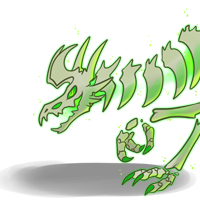
Pallor Fiend Demon (Boss)
Affiliation: Life
The pallor fiend demon is one of the more intimidating demons, though not particularly aggressive. It doesn’t need to be, as it can just breathe a poisonous fog at whatever threatens it. The fog, which glows the same eerie green color as the pallor fiend demon itself, can slow down even a charging quasar. It’s not immediately fatal, but seek prompt medical attention if you think there’s a chance you might have inhaled even a small amount.
Some mages have speculated about a possible connection between the lesser drachenleiche and the pallor fiend demon, but the two have little in common besides resembling skeletal dragons. The pallor fiend is, if anything, less of a threat than the lesser drachenleiche, as it can neither breathe acid nor control minds.
This post has been edited 1 times. Last edited on 10-31-2025 13:55:04.
Need site currency? Try playing with my hundreds of companions here. Companions may be played with once per hour (total, not per user). Check back later if nothing shows up.
Please note that I am not an admin, coder, or moderator. I've just been here forever. Ezriaphiel and Iaophiel are the two people in charge of the site.
Still on AO3 here - Forest of Mirrors, Dragon Cave, MagiStream, and original fiction.
Please note that I am not an admin, coder, or moderator. I've just been here forever. Ezriaphiel and Iaophiel are the two people in charge of the site.
Still on AO3 here - Forest of Mirrors, Dragon Cave, MagiStream, and original fiction.
Posted 09-08-2022 17:31:39
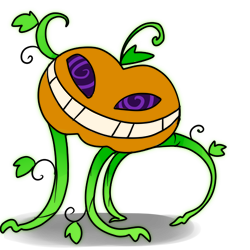
Pumpkin Demon
Affiliation: Thirteenth Year
The pumpkin demon is, like most Thirteenth Year demons, more of a nuisance than an actual threat. Its favorite trick is to hide in pumpkin patches and ambush the unwary, but it prefers to scare people rather than attack them. At worst, it will use its vinelike limbs to trip people up. They’re not even particularly good at ambushes, as they’ve never figured out that being the one grinning pumpkin in a patch doesn’t exactly help with blending in.
Pumpkin demons are competitive and not overly bright. They often start staring contests with carved pumpkins and grow frustrated when they don’t win. Their competitive nature can work to your advantage, though. If you can get close enough to stick a ribbon or medal on them without being bitten and then praise them, they will be so proud of having won something that they won’t notice their target escaping.
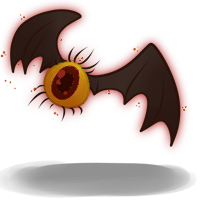
Seer Demon
Affiliation: Dark
The bat-sized seer demon consists of one large eye and two batlike wings. It can hypnotize anything that stares for too long into its single, unblinking eye, but luckily, the effect is weak and easily broken. Flocks of seer demons pose more of a threat, though it’s easy to distract flock members into hypnotizing each other (with the resulting collisions being highly amusing to watch).
The seer demon is sometimes called Eye of Tathoes, as some believe that entity uses them to spy on the world. However, despite not quite fitting the standard dark-affiliated color scheme, seer demons appear to be perfectly ordinary demons. Seer demons, as far as can be determined, can’t predict any part of the future, even their own defeat.
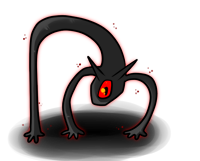
Slinker Demon
Affiliation: Dark
The slinker demon likes to chase anything that will run from it. As it’s small and slow, as well as seemingly incapable of moving without getting at least two of its three legs hopelessly tangled, almost everything can outdistance it. Even chaser demons can outrun it, despite their little stumpy legs.
Anything that fails to flee will soon find that the slinker demon is even more harmless than it appears. Lacking teeth to bite with, its main means of defense is to stretch itself up to appear larger and fiercer. As it’s barely knee-high to a human when stretched out to its fullest, this strategy barely even works with other slinker demons. Thus, the slinker demon usually must rely on its backup defense of melting into the closest shadows and fleeing.
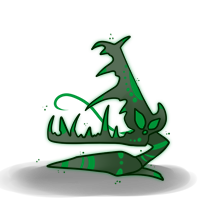
Snipper Demon
Affiliation: Leaf
The snipper demon resembles demonic (and oversized) gardening shears. Its jaws can cut through just about anything, given enough time and patience, though it prefers plants, which are less likely to bite back. It has a fondness for human-cultivated areas, which provide plenty of different textures to chew on. Fields that a snipper demon have passed through look like they were harvested by a particularly inept farmer, and saying that someone’s topiary looks like it was made by a snipper demon is a grave insult.
Snipper demons tend to be very single-minded. A snipper demon that is currently chewing up a tree trunk will ignore anything that isn’t directly attacking it. This is good for avoiding a fight, but bad if the snipper demon is chewing on a crop that you wanted to save.
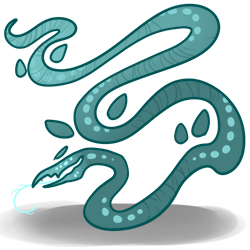
Sock Demon
Affiliation: Wind
Sock demons are actually named for their resemblance to windsocks and not for any particular fondness for a certain article of footwear. They will steal socks from an unguarded clothesline, but will also take along the rest of the clothes, the clothesline, and all the clothespins as well. Luckily, they don’t work their mischief indoors. As they are windsock-sized as well as shaped and easily grounded, they avoid narrow openings and small, enclosed spaces.
Sock demons are extremely distracted and will happily leave a battle to chase something that blows around well in the wind. Socks work, but so do a handful of paper scraps or any small, unsecured objects you might be carrying. Just be sure to avoid anything that the sock demon can turn against you, like glitter.
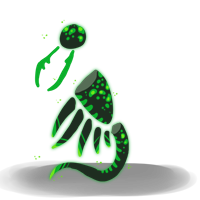
Solonid Demon
Affiliation: Life
An individual solonid demon is the size of a small dog and reasonably harmless, but solonid demons, much like the ants they vaguely resemble, rarely travel alone. Where there’s one, there are usually a few dozen more within easy summoning range. They can cast illusions to make themselves appear more numerous, so that it’s not always immediately clear whether you are fighting the genuine article or an illusion until it bites you.
The solonid demon devours crops, trees, and other plants in tiny, careful bites. It has no fondness for anything man-made, but often needs a few bites to be certain that it dislikes something. Luckily, what one discovers will be quickly passed on to the rest of the swarm, so having your house eaten by solonid demons is highly unlikely.
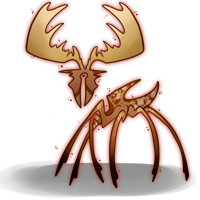
Spydeer Demon (Boss)
Affiliation: Leaf
The spydeer’s name refers both to its appearance (though individuals can have anywhere from six to ten legs, depending on age and relative luck in battle) and to the belief that they are spies for some unknown entity. They are often found near the edge of settlements, watching what goes on, and will frequently wander in for a quick snack of the entire contents of a garden.
Spydeer demons bear a strong resemblance to carrion demons, though they’re more of a moose to a carrion demon’s deer. Despite the similarity in color and general appearance, they are leaf-affiliated, not stone-affiliated. Why they are not the standard green color of leaf-affiliated demons is unclear, but it could be a form of camouflage that allows them to blend in among the trees for more effective spying.
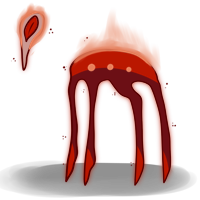
Stander Demon
Affiliation: Fire
The tall, long-legged stander demon is often found in patches of forest that have recently burned. Frequently, it was the cause of the fire, as its feet scorch the ground wherever it walks. A stander demon is hard to turn aside once it’s set its mind on going somewhere, but water magic can sometimes persuade it to go elsewhere.
Stander demons hate walker demons, burning the conjured plants and then scorching the ground with their feet so that no new plants can grow. For anything except walker demons (and confetti demons, which can often be found circling stander demons), stander demons prefer to remain still and let the opponent exhaust itself, then go to the effort of throwing fireballs.
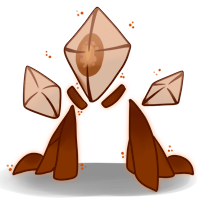
Stone Demon
Affiliation: Stone
The stone demon is one of the original eight types to infest the world. The most aggressive of the stone-affiliated demons (and, perhaps coincidentally, the smallest, though still not small), it uses strong earthquakes to topple structures, opponents, and bystanders.
Many stone demons collect rocks, usually of one specific type. Rocks that have been part of a stone demon’s hoard can be used as spell ingredients, but they are extremely risky to collect (a stone demon does not part with its treasures lightly and may come looking for what went missing) and look identical to normal rocks. These rocks, however, are not themselves dangerous. Like crystalline demon shards, they are safe to handle (risk of angry stone demon aside) and will not cause your skin or surroundings to become corrupted.
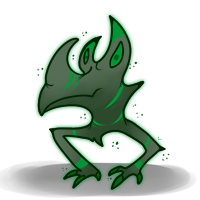
Thorin Demon
Affiliation: Leaf
The thorin demon is the smallest of the leaf demons, with most being of a size to sit comfortably on a large dinner plate. It is almost all head, except for two small legs, and much of its head is covered by several large thorn-like spikes. The frog-like legs allow it to jump startlingly high, allowing it to stab at the underside of an opponent.
While the thorin demon prefers to directly attack an opponent, it will also lie in wait in overgrown patches of plants so it can jab anything that walks over it. It can change color to match its surroundings, but the mimicry is rarely perfect and it’s usually easy to spot. Even if it can blend in, it will need to move on eventually. Plants growing near a thorin demon’s hiding place will always grow oversized thorns, no matter what type of plant they are.

Threshing Demon
Affiliation: Water
Despite the strong resemblance to a shark, the threshing demon is not particularly aggressive. Unless controlled by an outside force, the threshing demon prefers to keep to itself and will even ignore boats unless they pose some threat. It floats above the surface of the water and tends to ignore the other types of demons that do so. Fish demons seem to be not worth the effort of hunting, given that they’re mostly frilly fins, and gulper demons are too large to be prey.
The threshing demon hunts by using its control over water to create strong currents to disorient prey. The whirlpools it creates can sink ships, but ships are rarely the intended target. Threshing demons are not picky about their prey and will clean out entire lakes, then float to the next food source. They sometimes hunt in schools, but these arrangements rarely last long and are generally broken up by disagreements over food.

Vile Demon
Affiliation: Edgelands
The serpentine vile demon is extremely hard to surprise, as it has enough eyes to keep one on you and one on your battle champion, with at least one or two left over to watch for sneak attacks. Unlike some of the other Edgelands demons, it is highly aggressive and will attack unprovoked. Any wound it causes will fester and may develop odd infections, so prompt medical attention will be required. The best strategy for escaping one is to hope for a suitably compelling distraction.
The largest and most formidable of the known Edgelands demons, though far from the largest demon, the vile demon has size, strength, and speed in its favor, as well as a mouth full of very sharp teeth. However, it’s not quite large enough or strong enough (or rare enough) to be classified as a boss demon. It may be a work in progress or there may be an even stronger Edgelands demon lurking out beyond the pillars. Neither possibility is particularly encouraging.
This post has been edited 1 times. Last edited on 10-31-2025 13:57:40.
Need site currency? Try playing with my hundreds of companions here. Companions may be played with once per hour (total, not per user). Check back later if nothing shows up.
Please note that I am not an admin, coder, or moderator. I've just been here forever. Ezriaphiel and Iaophiel are the two people in charge of the site.
Still on AO3 here - Forest of Mirrors, Dragon Cave, MagiStream, and original fiction.
Please note that I am not an admin, coder, or moderator. I've just been here forever. Ezriaphiel and Iaophiel are the two people in charge of the site.
Still on AO3 here - Forest of Mirrors, Dragon Cave, MagiStream, and original fiction.
Posted 09-08-2022 17:33:42
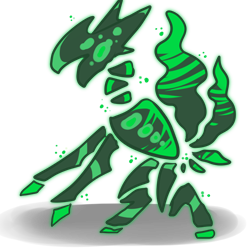
Walker Demon
Affiliation: Leaf
The vaguely horse-like walker demon grows plants wherever it walks. This might be welcome if the plants weren’t corrupted and often malevolent. The plants will stop trying to attack anything in sight within a few minutes, but the corruption takes longer to fade.
Contrary to popular rumor, eating a plant that a walker demon has created will not turn the unlucky individual into a demon. Yes, eating one of these plants is a bad idea, but that’s because, as with eating unknown mushroom varieties, you are likely to discover a new and exciting way to be poisoned.
A walker demon has a venomous bite, poisonous skin and a nasty temperament. Both it and its plant army should be approached with caution. Walker demons don’t get along with any creature, even other demons, and have a particular feud with stander demons, who like to burn their plants.

Water Demon
Affiliation: Water
The water demon is one of the original eight types to infest the world. Large and largely sedentary, it moves from place to place by undulating the frill at the base of its round body. It can give a nasty bite with its powerful jaws, but prefers to shoot water at an opponent.
Unlike other water-affiliated demons, the water demon is not tied to any particular body of water and doesn’t even need a particularly moist environment. It’s just as happy in a dry environment trying to drown fire-affiliated demons as it is in a bog trying to shoot wind-affiliated demons out of the sky with geysers of water.
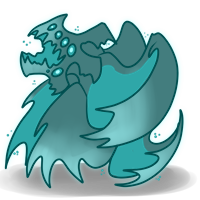
Wind Demon
Affiliation: Wind
The wind demon is one of the original eight types to infest the world. It mostly consists of wings – either six or twelve, depending on whether one counts the six wing-like frills on the head as actual wings. All of those wings make it highly maneuverable in the air and also allow it to send strong, highly accurate gusts of wind at opponents.
A skilled aerial predator, the wind demon also has a warped sense of humor. It likes to levitate things that shouldn’t be levitated, drop them a few inches, catch them, and repeat the process until everything is back on the ground. Wind demons are also known for watching for items that seem important to humans and then using gusts of wind to blow the items somewhere inaccessible once everyone’s back is turned. Carts and carriages are favored targets.
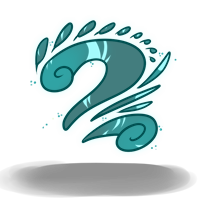
Wisp Demon
Affiliation: Wind
Despite a superficial similarity in appearance, the wisp demon has little in common with the small demon of the same name. Not only is it larger, but it’s also far more aggressive. While the small demon will run if it thinks it’s being observed, the full-sized variety will tear battle tickets right out of your hand and then send gusts of winds to empty out your pockets.
Unlike larger wind-affiliated demons, the wisp demon can’t create wind gusts strong enough to knock humans off their feet, but can sweep away smaller battle champions. It also uses gusts of wind to fight with other wisp demons, as generally happens when more than a couple gather in one place. A group of wisp demons is hypothetically known as a flurry, but they never work together for long enough for a collective name to be necessary.
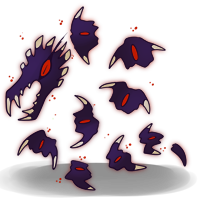
Writhing Demon (Boss)
Affiliation: Wind
The serpentine writhing demon, like all other known boss demons except the devourer demon, has a coloration that doesn’t quite match its affinity. In fact, the coloration aligns with no known affinity. This would be concerning, as a possible sign of some as-yet-unknown clan, but careful study has confirmed that, yes, the writhing demon is indeed wind-affiliated.
The writhing demon is of moderate size for a boss demon and doesn’t possess any particularly alarming attacks, but it’s still a challenge to face in battle. The individual segments are capable of independent motion and have eyes so they can see where they’re going, so fighting a writhing demon is like fighting one of the multi-body demons, like the flock or ovid demons. Luckily, the writhing demon is (relatively) easily defeated. All you need is to find a way to immobilize all of the body segments, after which the head will drop to the ground and be about as agile as a crawler demon.
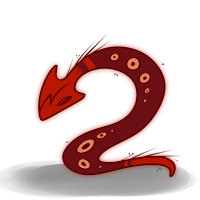
Wyrm Demon
Affiliation: Fire
Serpentine in appearance, the wyrm demon combines the firepower of a dragon with the burrowing ability of an earthworm (or perhaps that should be earthwyrm, in this case). The average wyrm demon is about the length of an arcane demon, but as wyrm demons never stop growing, there may be older individuals out there that rival the devourer demon in size.
It’s usually possible to spot wyrm demon tunnels by the charred plants that follow the tunnel’s path, but sometimes the only sign of a wyrm demon’s presence is abnormally warm soil. A wyrm demon that’s underground is no particular threat unless it surfaces, which it tends not to do unless flooded out, but one that’s come to the surface is far more dangerous. It can and will breathe fire, as well as wrap itself around the legs of whatever it views as a threat.
This post has been edited 1 times. Last edited on 10-31-2025 13:59:15.
Need site currency? Try playing with my hundreds of companions here. Companions may be played with once per hour (total, not per user). Check back later if nothing shows up.
Please note that I am not an admin, coder, or moderator. I've just been here forever. Ezriaphiel and Iaophiel are the two people in charge of the site.
Still on AO3 here - Forest of Mirrors, Dragon Cave, MagiStream, and original fiction.
Please note that I am not an admin, coder, or moderator. I've just been here forever. Ezriaphiel and Iaophiel are the two people in charge of the site.
Still on AO3 here - Forest of Mirrors, Dragon Cave, MagiStream, and original fiction.
Posted 10-31-2022 21:27:39
Wow..cool. Hope there will be some new demons too. The guide is really neat.
I am here too...https://subeta.net/?refer=Bendy_Demon
Posted 10-31-2025 14:00:51
For Halloween, I've uploaded a revised and expanded version (over half again as long as the first version) with updated affiliations for three of the boss demons (thanks to dxsire). Every single demon has an expanded description. This version is also up on AO3, though without pictures.
This post has been edited 1 times. Last edited on 10-31-2025 14:29:52.
Need site currency? Try playing with my hundreds of companions here. Companions may be played with once per hour (total, not per user). Check back later if nothing shows up.
Please note that I am not an admin, coder, or moderator. I've just been here forever. Ezriaphiel and Iaophiel are the two people in charge of the site.
Still on AO3 here - Forest of Mirrors, Dragon Cave, MagiStream, and original fiction.
Please note that I am not an admin, coder, or moderator. I've just been here forever. Ezriaphiel and Iaophiel are the two people in charge of the site.
Still on AO3 here - Forest of Mirrors, Dragon Cave, MagiStream, and original fiction.
⇦ prev
1
next ⇨
Reply

